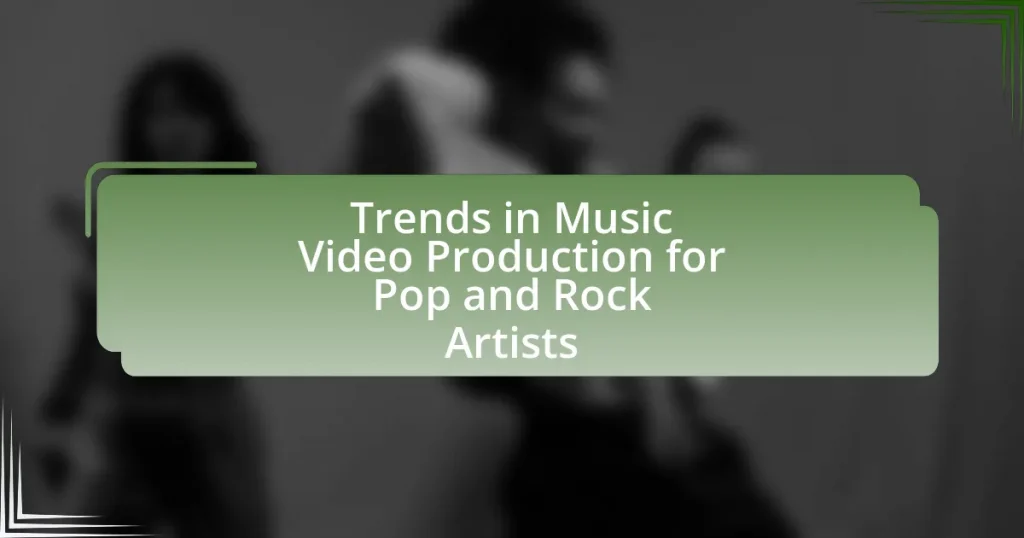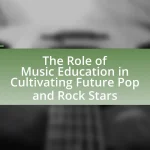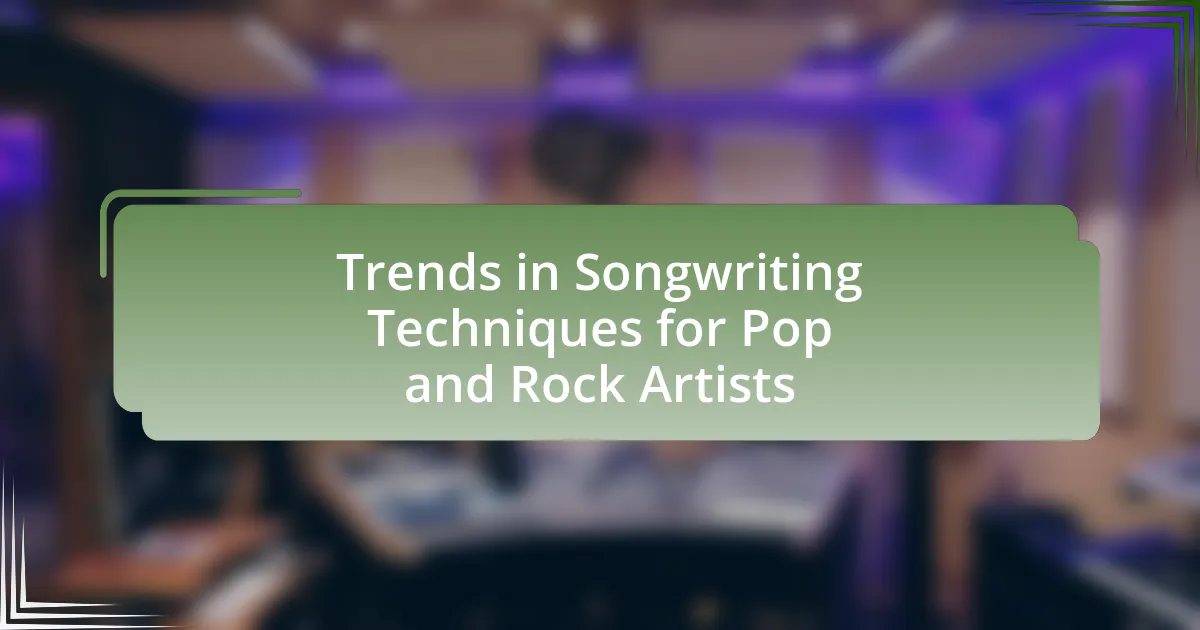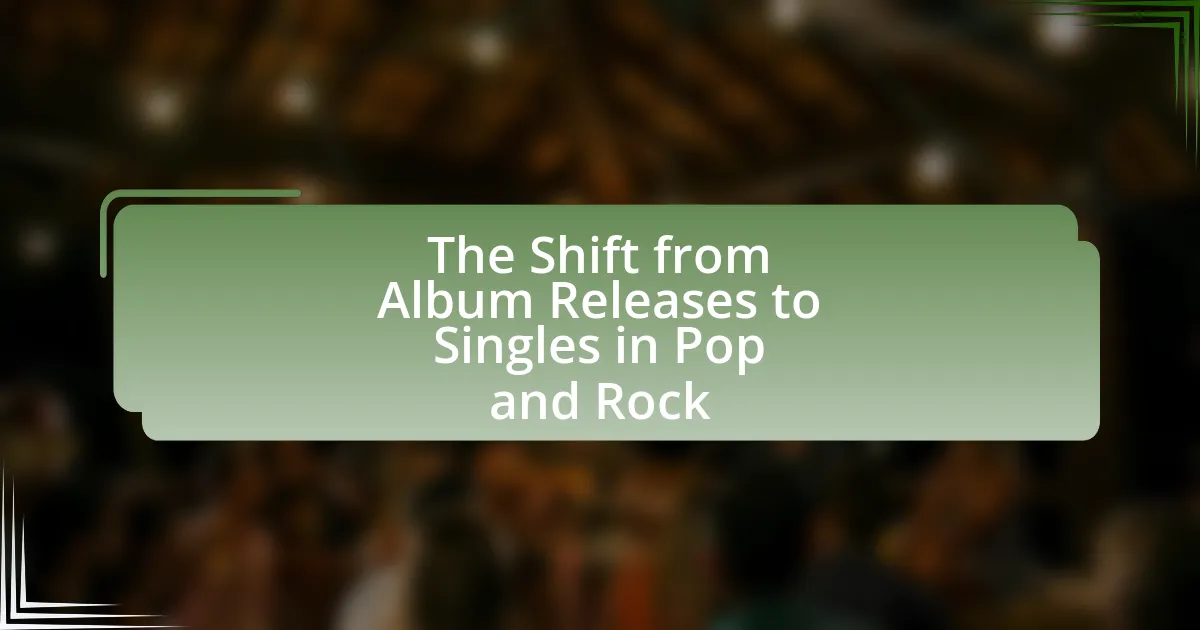The article focuses on current trends in music video production for pop and rock artists, highlighting the integration of high-quality visual effects, storytelling narratives, and interactive elements. It examines how technological advancements, such as the use of drones and digital effects, have transformed the production landscape, enabling more dynamic and engaging content. Additionally, the article discusses emerging storytelling styles, popular themes, and the impact of social media on video promotion and audience engagement. It also addresses the challenges artists face, including budget constraints and legal issues, while providing best practices for successful music video production.
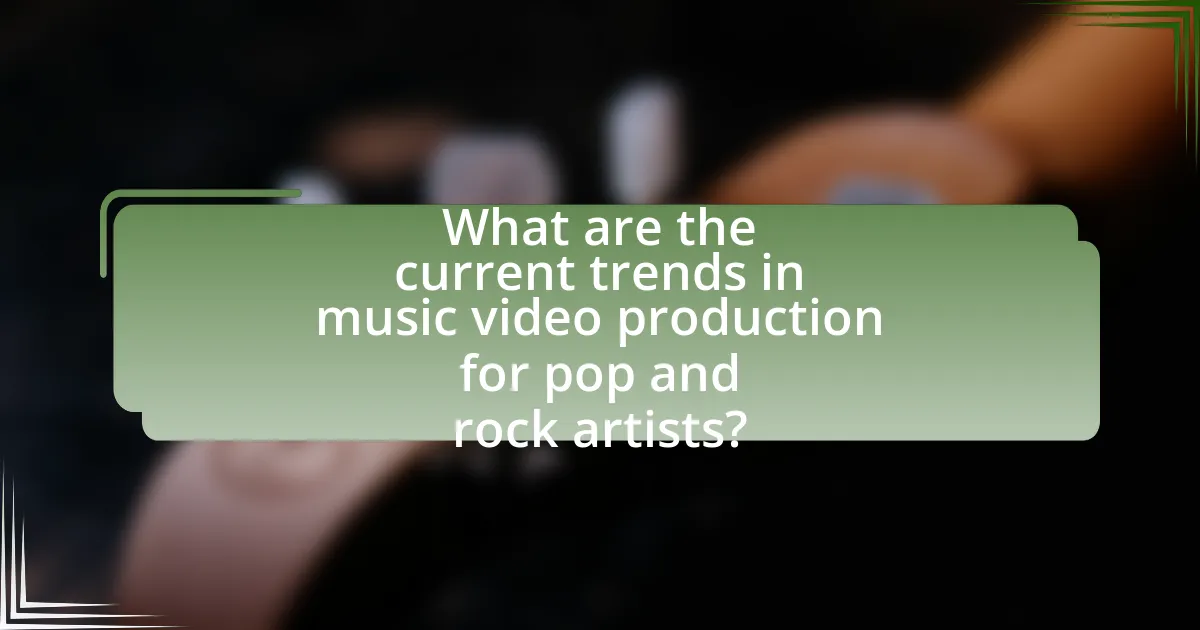
What are the current trends in music video production for pop and rock artists?
Current trends in music video production for pop and rock artists include the use of high-quality visual effects, storytelling narratives, and interactive elements. High-quality visual effects enhance the aesthetic appeal and engage viewers, while storytelling narratives create emotional connections with the audience, as seen in recent videos by artists like Taylor Swift and Coldplay. Additionally, interactive elements, such as 360-degree videos and augmented reality experiences, are increasingly popular, allowing fans to engage with the content in innovative ways. These trends reflect the industry’s shift towards creating immersive and visually captivating experiences that resonate with audiences.
How have technological advancements influenced music video production?
Technological advancements have significantly transformed music video production by enhancing visual quality, enabling innovative storytelling techniques, and streamlining the production process. The introduction of high-definition cameras and digital editing software has allowed creators to produce visually stunning content with greater ease and efficiency. For instance, the use of 4K resolution cameras has become standard, providing clearer and more vibrant images that enhance viewer engagement. Additionally, advancements in CGI and animation have opened new avenues for creative expression, allowing artists to visualize concepts that were previously impossible. The rise of platforms like YouTube and social media has also shifted the focus towards shorter, more dynamic videos, influencing how artists approach their visual storytelling. These changes reflect a broader trend where technology not only improves production quality but also shapes the artistic direction of music videos.
What role do digital effects play in modern music videos?
Digital effects play a crucial role in modern music videos by enhancing visual storytelling and creating immersive experiences. These effects allow artists to convey emotions and themes that align with their music, often transforming ordinary scenes into extraordinary visuals. For instance, the use of CGI and animation can create fantastical environments that reflect the song’s mood, as seen in videos like “Sledgehammer” by Peter Gabriel, which utilized groundbreaking stop-motion animation techniques. Furthermore, digital effects can also facilitate seamless transitions and dynamic editing styles, making the final product more engaging for viewers. This integration of technology not only captivates audiences but also sets a high standard for visual creativity in the music industry.
How has the use of drones changed the landscape of music video filming?
The use of drones has significantly transformed music video filming by enabling dynamic aerial shots and unique perspectives that were previously difficult or costly to achieve. Drones allow filmmakers to capture sweeping landscapes and intricate choreography from above, enhancing visual storytelling. For instance, the 2016 music video for “Cold” by Maroon 5 utilized drone technology to create captivating aerial views, showcasing the versatility and creativity drones bring to production. This innovation has led to increased accessibility for independent artists, as drone technology has become more affordable, allowing a broader range of creators to produce high-quality visuals without the need for extensive budgets or equipment.
What are the emerging styles in music video storytelling?
Emerging styles in music video storytelling include narrative-driven concepts, interactive experiences, and cinematic aesthetics. Narrative-driven concepts often feature short films that convey a story aligned with the song’s themes, enhancing emotional engagement. Interactive experiences allow viewers to influence the video’s direction, creating a personalized connection with the content. Cinematic aesthetics utilize high production values, advanced visual effects, and artistic cinematography to elevate the overall viewing experience. These styles reflect the evolving landscape of music video production, where artists aim to create more immersive and engaging content for their audiences.
How do narrative-driven videos differ from performance-based videos?
Narrative-driven videos focus on storytelling, presenting a structured plot that engages viewers emotionally, while performance-based videos emphasize the artist’s musical performance, showcasing their talent and energy without a specific storyline. Narrative-driven videos often include character development and thematic elements, as seen in works like “Thriller” by Michael Jackson, which tells a cohesive story. In contrast, performance-based videos, such as “Uptown Funk” by Mark Ronson featuring Bruno Mars, prioritize visual spectacle and the artist’s charisma over a narrative arc. This distinction highlights how narrative-driven videos aim to evoke emotions through storytelling, whereas performance-based videos aim to entertain through musical expression.
What themes are becoming popular in music video narratives?
Popular themes in music video narratives include mental health awareness, social justice issues, and personal empowerment. These themes resonate with audiences as artists increasingly use their platforms to address contemporary societal challenges. For instance, music videos often depict struggles with anxiety and depression, reflecting a growing openness about mental health, as seen in works by artists like Logic and Billie Eilish. Additionally, social justice themes have gained traction, with videos highlighting movements such as Black Lives Matter, exemplified by artists like Kendrick Lamar. Personal empowerment narratives, often featuring themes of self-love and resilience, are also prevalent, as demonstrated in videos by artists like Lizzo. These trends indicate a shift towards more meaningful and relatable content in music video storytelling.
How do social media platforms impact music video production?
Social media platforms significantly influence music video production by enabling artists to reach wider audiences and engage with fans directly. These platforms facilitate the sharing of content, allowing music videos to gain viral traction quickly, which can lead to increased views and popularity. For instance, a study by the International Journal of Music Business Research found that music videos promoted on social media platforms like Instagram and TikTok experienced a 50% increase in viewership compared to those that were not. Additionally, artists often tailor their video content to fit the aesthetics and trends prevalent on these platforms, ensuring that their work resonates with the audience and encourages sharing. This shift towards social media-centric production has transformed traditional marketing strategies, making them more interactive and audience-driven.
What strategies are artists using to promote their videos on social media?
Artists are using targeted social media advertising, influencer collaborations, and engaging content to promote their videos. Targeted advertising allows artists to reach specific demographics, increasing the likelihood of engagement; for instance, platforms like Facebook and Instagram offer tools to tailor ads based on user interests and behaviors. Collaborating with influencers helps artists tap into established audiences, as influencers can share the videos with their followers, amplifying reach. Additionally, creating engaging content, such as behind-the-scenes footage or interactive posts, encourages audience participation and sharing, which can lead to organic growth in viewership. These strategies are supported by data showing that social media campaigns can significantly boost video views and engagement rates.
How does audience engagement on platforms like TikTok influence video content?
Audience engagement on platforms like TikTok significantly influences video content by driving trends and shaping creative decisions. The platform’s algorithm prioritizes content that garners high engagement, such as likes, shares, and comments, leading creators to tailor their videos to resonate with audience preferences. For instance, viral challenges and popular sounds often dictate the style and format of music videos, encouraging artists to adopt these elements to maximize reach and visibility. Data shows that videos aligned with trending topics on TikTok can achieve millions of views, demonstrating the direct correlation between audience interaction and content success.
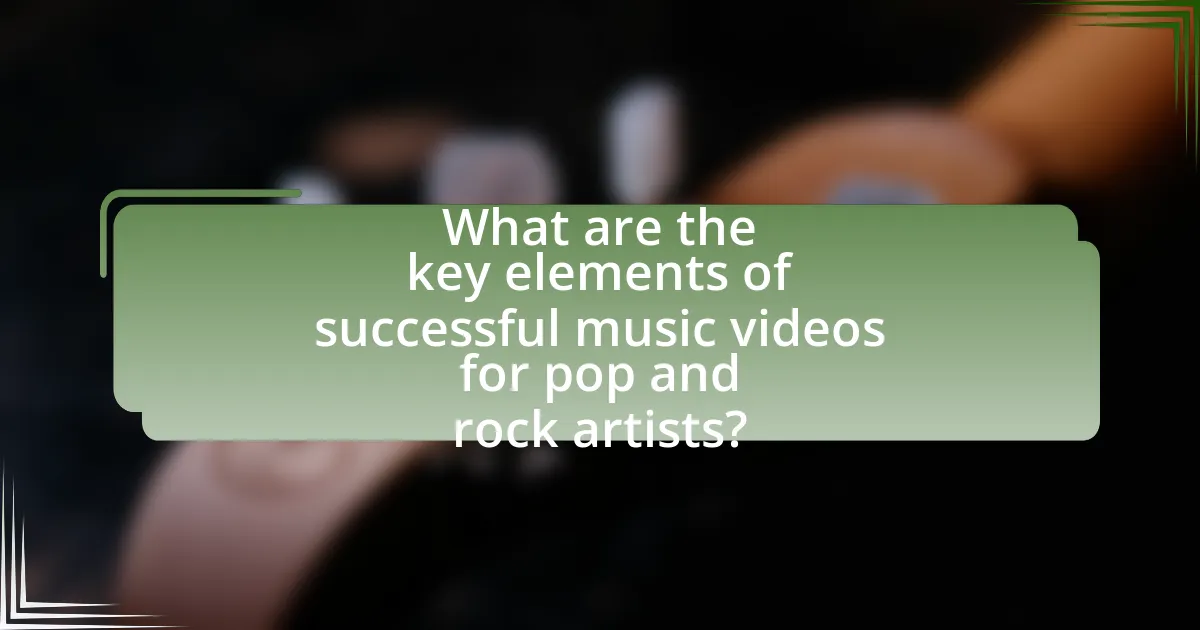
What are the key elements of successful music videos for pop and rock artists?
Successful music videos for pop and rock artists typically include strong visual storytelling, high production quality, and engaging choreography. Visual storytelling captivates the audience by conveying the song’s narrative or emotional themes, which enhances viewer connection. High production quality, including professional cinematography and editing, ensures that the video stands out in a competitive market, as evidenced by the success of videos like “Thriller” by Michael Jackson, which set industry standards. Engaging choreography, often featuring memorable dance routines, helps to create viral moments, as seen in videos like “Uptown Funk” by Mark Ronson featuring Bruno Mars, which contributed to its widespread popularity. These elements collectively contribute to the overall impact and success of music videos in the pop and rock genres.
How important is visual aesthetics in music video production?
Visual aesthetics are crucial in music video production as they significantly influence audience engagement and emotional response. Research indicates that visually appealing videos can enhance viewer retention and increase the likelihood of sharing, which is vital in a competitive digital landscape. For instance, a study by the University of Southern California found that videos with high production quality and strong visual elements can boost viewer engagement by up to 80%. This underscores the importance of visual aesthetics in creating memorable and impactful music videos that resonate with audiences.
What color palettes are trending in pop and rock music videos?
Trending color palettes in pop and rock music videos include vibrant neons, pastel hues, and monochromatic schemes. These palettes reflect current cultural aesthetics and are often used to evoke specific emotions or themes. For instance, vibrant neons are frequently employed to create a sense of energy and excitement, while pastel colors convey a softer, nostalgic feel. Monochromatic schemes, on the other hand, are utilized for their minimalist appeal, allowing the focus to remain on the artist and the narrative. This trend aligns with the visual strategies seen in recent popular music videos, such as those by artists like Dua Lipa and Billie Eilish, who have effectively used these color palettes to enhance their artistic expression and connect with audiences.
How do costume and set design contribute to a music video’s success?
Costume and set design significantly enhance a music video’s success by visually representing the song’s themes and emotions. Effective costume choices can create a strong character identity, while set design establishes the overall mood and context, making the video more engaging for viewers. For instance, iconic music videos like Michael Jackson’s “Thriller” utilized elaborate costumes and sets to create a memorable narrative, contributing to its lasting impact and popularity. This alignment of visual elements with the music not only captivates the audience but also reinforces the artist’s brand, leading to increased viewership and commercial success.
What role does choreography play in music videos?
Choreography plays a crucial role in music videos by enhancing the visual storytelling and emotional impact of the song. It serves to engage viewers, create memorable moments, and complement the music’s rhythm and themes. For instance, iconic dance sequences in music videos, such as those in Michael Jackson’s “Thriller,” not only showcase the artist’s talent but also contribute to the video’s narrative and cultural significance. Research indicates that well-executed choreography can increase viewer retention and enjoyment, making it a vital element in the production of pop and rock music videos.
How can choreography enhance the storytelling aspect of a music video?
Choreography enhances the storytelling aspect of a music video by visually expressing the emotions and themes conveyed in the song. Through synchronized movements and dance sequences, choreography can illustrate narrative elements, such as conflict, romance, or celebration, making the story more engaging for viewers. For instance, in Beyoncé’s “Single Ladies,” the choreography not only complements the lyrics but also emphasizes themes of empowerment and independence, effectively reinforcing the song’s message. This integration of dance and narrative allows audiences to connect more deeply with the music, as the physical expression of the performers adds layers of meaning to the visual storytelling.
What are the current trends in dance styles featured in music videos?
Current trends in dance styles featured in music videos include a blend of hip-hop, contemporary, and viral social media dance challenges. Hip-hop remains dominant due to its cultural significance and adaptability, while contemporary dance adds emotional depth and storytelling elements. Viral dance challenges, often originating on platforms like TikTok, have become integral, as they engage audiences and encourage participation. For instance, the “Savage Love” dance challenge significantly boosted the song’s popularity, illustrating how these trends can directly impact music success.
How do collaborations influence music video production?
Collaborations significantly enhance music video production by combining creative visions and resources from multiple artists. This synergy often results in innovative concepts, diverse styles, and increased production quality, as seen in high-profile collaborations like “Shallow” by Lady Gaga and Bradley Cooper, which featured a visually striking narrative that complemented the song’s emotional depth. Additionally, collaborations can expand audience reach; for instance, when artists from different genres work together, they tap into each other’s fan bases, leading to higher viewership and engagement. This trend is supported by data showing that collaborative music videos often achieve higher streaming numbers and social media shares compared to solo projects, illustrating the positive impact of partnerships in the music video landscape.
What benefits do artists gain from collaborating with directors and producers?
Artists gain enhanced creative vision and broader audience reach from collaborating with directors and producers. This collaboration allows artists to leverage the expertise of directors in visual storytelling and production techniques, resulting in more impactful music videos. For instance, a well-directed music video can significantly increase an artist’s visibility; according to a study by Nielsen, music videos can boost song streams by up to 200%. Additionally, producers often bring industry connections and marketing strategies that can elevate an artist’s profile, leading to increased opportunities for performances and collaborations.
How do guest appearances affect the reception of a music video?
Guest appearances significantly enhance the reception of a music video by attracting a broader audience and increasing viewer engagement. When a well-known artist features in a music video, their fanbase is likely to engage with the content, leading to higher view counts and social media shares. For instance, the collaboration between Travis Scott and Drake in the music video for “Sicko Mode” resulted in over 1 billion views on YouTube, showcasing how guest appearances can drive massive audience interest. Additionally, studies indicate that videos featuring guest artists often receive more favorable reviews from critics, as the collaboration can add diversity and appeal to the overall production.
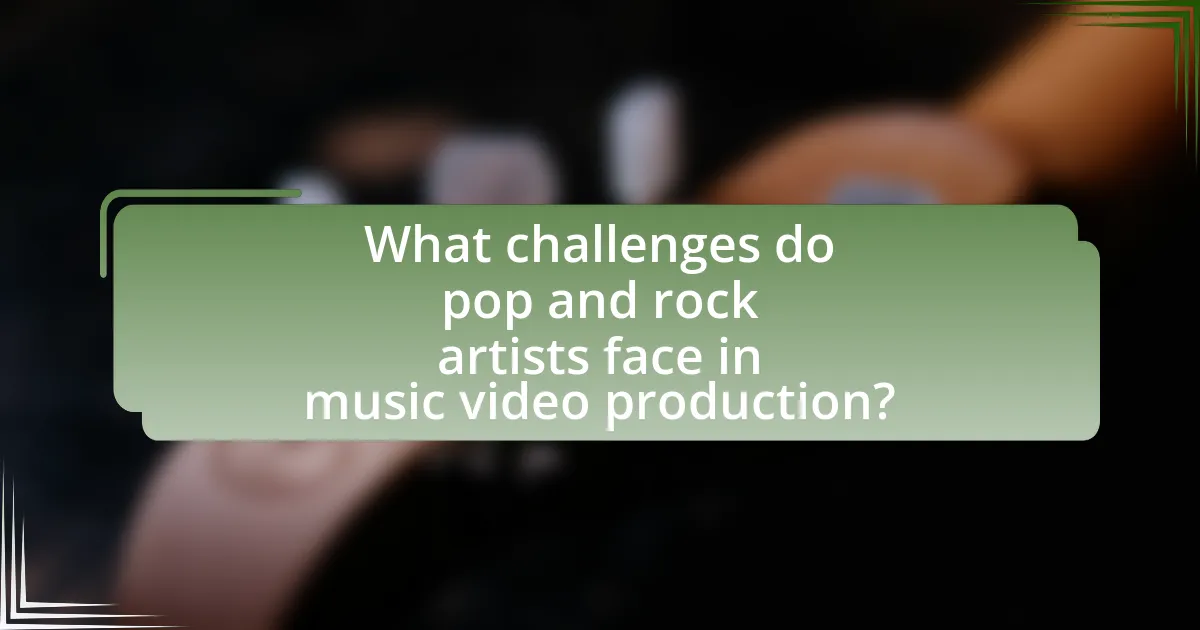
What challenges do pop and rock artists face in music video production?
Pop and rock artists face several challenges in music video production, including budget constraints, creative differences, and time limitations. Budget constraints often restrict the scope of production, limiting the ability to hire top talent or secure high-quality locations. Creative differences can arise between artists and directors, leading to conflicts over the vision and execution of the video. Time limitations are also a significant challenge, as artists must often produce videos quickly to align with album releases or promotional schedules. These factors collectively impact the quality and effectiveness of the final product, making it essential for artists to navigate these challenges strategically.
How do budget constraints impact music video quality?
Budget constraints significantly reduce music video quality by limiting resources for production elements such as location, equipment, and talent. When budgets are tight, artists often cannot afford high-quality cameras, professional crews, or elaborate sets, which directly affects the visual appeal and overall production value of the video. For instance, a study by the International Journal of Music Business Research found that music videos with budgets exceeding $100,000 typically receive higher viewer engagement and critical acclaim compared to those produced for less than $10,000. This correlation highlights how financial limitations can lead to less polished and impactful visual storytelling in music videos.
What are common budget allocation strategies for music video production?
Common budget allocation strategies for music video production include prioritizing key elements such as talent, location, and post-production. Typically, a significant portion of the budget, often around 30-40%, is allocated to hiring artists and crew, including directors and cinematographers. Location costs, which can account for 20-30% of the budget, are crucial for setting the visual tone of the video. Additionally, post-production expenses, including editing and visual effects, usually take up 15-25% of the budget. These allocations reflect industry standards, as outlined in reports from organizations like the Music Video Production Association, which emphasize the importance of strategic financial planning to maximize production quality and audience engagement.
How can artists maximize their production value on a limited budget?
Artists can maximize their production value on a limited budget by leveraging creative storytelling, utilizing affordable technology, and collaborating with emerging talent. Creative storytelling allows artists to engage audiences without relying on expensive sets or effects; for instance, narrative-driven videos can captivate viewers through compelling plots. Affordable technology, such as high-quality smartphones and accessible editing software, enables artists to produce visually appealing content without significant financial investment. Collaborating with emerging talent, including local filmmakers and artists, can also enhance production quality while sharing costs, as many are eager to build their portfolios. These strategies have been successfully employed by various independent artists, demonstrating that impactful music videos can be created without substantial financial resources.
What legal issues should artists be aware of in music video production?
Artists should be aware of copyright infringement, contract disputes, and licensing issues in music video production. Copyright infringement can occur if artists use copyrighted music, visuals, or other content without permission, leading to potential legal action. Contract disputes may arise from agreements with directors, producers, or collaborators, necessitating clear terms to avoid misunderstandings. Additionally, licensing issues involve obtaining rights for any third-party content, such as locations or props, which is essential to ensure legal compliance and avoid financial penalties.
How do copyright laws affect the use of music and visuals in videos?
Copyright laws significantly restrict the use of music and visuals in videos by protecting the intellectual property rights of creators. These laws require that any music or visual content used in a video must either be licensed or fall under fair use, which is often a complex legal standard. For instance, using a copyrighted song without permission can lead to legal action, including takedown notices or financial penalties, as established by the Digital Millennium Copyright Act (DMCA) in the United States. Additionally, platforms like YouTube enforce copyright policies that automatically detect and block unauthorized content, further emphasizing the importance of adhering to copyright laws in video production.
What are the implications of licensing agreements for music videos?
Licensing agreements for music videos have significant implications for artists, producers, and distributors. These agreements dictate how a music video can be used, including distribution rights, revenue sharing, and the duration of usage. For instance, a licensing agreement may specify that a music video can only be shown on certain platforms or for a limited time, which can affect an artist’s exposure and revenue potential. Additionally, licensing agreements often include terms regarding royalties, which can impact the financial success of both the artist and the production team. According to the U.S. Copyright Office, proper licensing ensures that creators are compensated for their work, thereby fostering a sustainable creative industry.
What best practices can artists follow to ensure successful music video production?
Artists can ensure successful music video production by meticulously planning their concepts, collaborating with experienced professionals, and maintaining a clear budget. Effective pre-production planning involves developing a strong narrative or theme that aligns with the song’s message, which enhances viewer engagement. Collaborating with skilled directors, cinematographers, and editors can elevate the production quality, as their expertise contributes to a polished final product. Additionally, adhering to a well-defined budget prevents overspending and allows for resource allocation to essential elements such as location, equipment, and talent. These practices are supported by industry standards, which emphasize the importance of preparation and collaboration in achieving high-quality music videos.
How can artists effectively plan their music video shoots?
Artists can effectively plan their music video shoots by establishing a clear concept, creating a detailed storyboard, and coordinating logistics such as location, crew, and equipment. A well-defined concept ensures that the video aligns with the song’s message and the artist’s brand, while a storyboard visually outlines each scene, facilitating smoother execution during filming. Additionally, organizing logistics, including securing locations and hiring a skilled crew, is crucial for maintaining a production schedule and budget. Research indicates that thorough pre-production planning can reduce on-set issues by up to 30%, highlighting the importance of these steps in achieving a successful music video shoot.
What tips can help artists collaborate successfully with production teams?
Artists can collaborate successfully with production teams by establishing clear communication from the outset. This involves discussing project goals, timelines, and creative visions to ensure alignment. Regular check-ins throughout the production process can help address any issues promptly, fostering a collaborative environment. Additionally, artists should be open to feedback and willing to adapt their ideas, as production teams often bring valuable expertise and perspectives that can enhance the final product. Research indicates that effective collaboration can lead to higher quality outcomes, as seen in successful music video projects where artists and production teams maintained strong communication and mutual respect.
